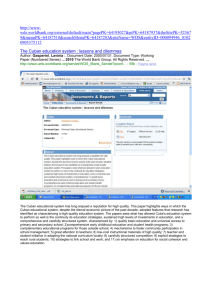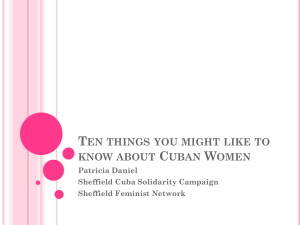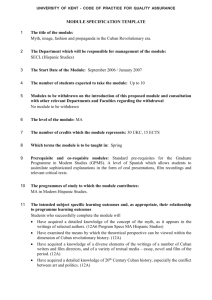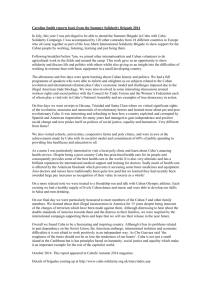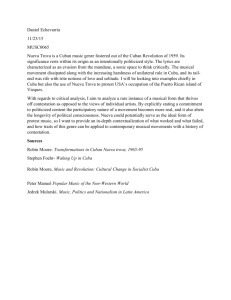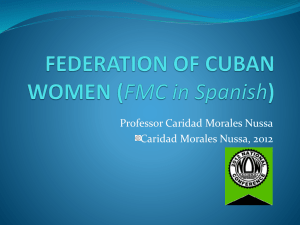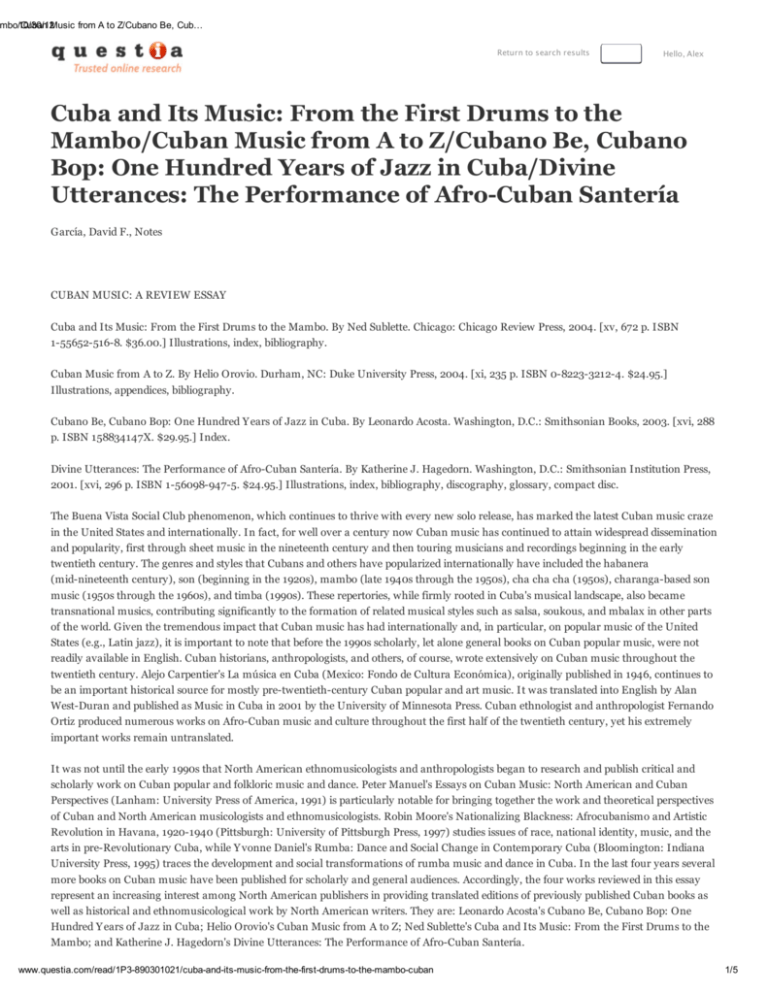
mbo/Cuban
10/30/12Music from A to Z/Cubano Be, Cub…
Return to search results
Hello, Alex
Cuba and Its Music: From the First Drums to the
Mambo/Cuban Music from A to Z/Cubano Be, Cubano
Bop: One Hundred Years of Jazz in Cuba/Divine
Utterances: The Performance of Afro-Cuban Santería
García, David F., Notes
CUBAN MUSIC: A REVIEW ESSAY
Cuba and Its Music: From the First Drums to the Mambo. By Ned Sublette. Chicago: Chicago Review Press, 2004. [xv, 672 p. ISBN
1-55652-516-8. $36.00.] Illustrations, index, bibliography.
Cuban Music from A to Z. By Helio Orovio. Durham, NC: Duke University Press, 2004. [xi, 235 p. ISBN 0-8223-3212-4. $24.95.]
Illustrations, appendices, bibliography.
Cubano Be, Cubano Bop: One Hundred Y ears of Jazz in Cuba. By Leonardo Acosta. Washington, D.C.: Smithsonian Books, 2003. [xvi, 288
p. ISBN 158834147X. $29.95.] Index.
Divine Utterances: The Performance of Afro-Cuban Santería. By Katherine J. Hagedorn. Washington, D.C.: Smithsonian Institution Press,
2001. [xvi, 296 p. ISBN 1-56098-947-5. $24.95.] Illustrations, index, bibliography, discography, glossary, compact disc.
The Buena Vista Social Club phenomenon, which continues to thrive with every new solo release, has marked the latest Cuban music craze
in the United States and internationally. In fact, for well over a century now Cuban music has continued to attain widespread dissemination
and popularity, first through sheet music in the nineteenth century and then touring musicians and recordings beginning in the early
twentieth century. The genres and styles that Cubans and others have popularized internationally have included the habanera
(mid-nineteenth century), son (beginning in the 1920s), mambo (late 1940s through the 1950s), cha cha cha (1950s), charanga-based son
music (1950s through the 1960s), and timba (1990s). These repertories, while firmly rooted in Cuba's musical landscape, also became
transnational musics, contributing significantly to the formation of related musical styles such as salsa, soukous, and mbalax in other parts
of the world. Given the tremendous impact that Cuban music has had internationally and, in particular, on popular music of the United
States (e.g., Latin jazz), it is important to note that before the 1990s scholarly, let alone general books on Cuban popular music, were not
readily available in English. Cuban historians, anthropologists, and others, of course, wrote extensively on Cuban music throughout the
twentieth century. Alejo Carpentier's La música en Cuba (Mexico: Fondo de Cultura Económica), originally published in 1946, continues to
be an important historical source for mostly pre-twentieth-century Cuban popular and art music. It was translated into English by Alan
West-Duran and published as Music in Cuba in 2001 by the University of Minnesota Press. Cuban ethnologist and anthropologist Fernando
Ortiz produced numerous works on Afro-Cuban music and culture throughout the first half of the twentieth century, yet his extremely
important works remain untranslated.
It was not until the early 1990s that North American ethnomusicologists and anthropologists began to research and publish critical and
scholarly work on Cuban popular and folkloric music and dance. Peter Manuel's Essays on Cuban Music: North American and Cuban
Perspectives (Lanham: University Press of America, 1991) is particularly notable for bringing together the work and theoretical perspectives
of Cuban and North American musicologists and ethnomusicologists. Robin Moore's Nationalizing Blackness: Afrocubanismo and Artistic
Revolution in Havana, 1920-1940 (Pittsburgh: University of Pittsburgh Press, 1997) studies issues of race, national identity, music, and the
arts in pre-Revolutionary Cuba, while Y vonne Daniel's Rumba: Dance and Social Change in Contemporary Cuba (Bloomington: Indiana
University Press, 1995) traces the development and social transformations of rumba music and dance in Cuba. In the last four years several
more books on Cuban music have been published for scholarly and general audiences. Accordingly, the four works reviewed in this essay
represent an increasing interest among North American publishers in providing translated editions of previously published Cuban books as
well as historical and ethnomusicological work by North American writers. They are: Leonardo Acosta's Cubano Be, Cubano Bop: One
Hundred Y ears of Jazz in Cuba; Helio Orovio's Cuban Music from A to Z; Ned Sublette's Cuba and Its Music: From the First Drums to the
Mambo; and Katherine J. Hagedorn's Divine Utterances: The Performance of Afro-Cuban Santería.
www.questia.com/read/1P3-890301021/cuba-and-its-music-from-the-first-drums-to-the-mambo-cuban
1/5
mbo/Cuban
10/30/12Music from A to Z/Cubano Be, Cub…
The Cuban writer Leonardo Acosta is the author of numerous studies on Cuban music, culture, and literature. His Cubano Be, Cubano Bop
is an English translation and condensed version of what was originally published in Spanish as two separate volumes (Descarga cubana: el
jazz en Cuba, 1900-1950 [La Habana: Ediciones Union, 2000] and Descarga numúro dos: el jazz en Cuba, 1950-2000 [La Habana:
Ediciones Union, 2002]). For this work Acosta draws from his forty-year career as a jazz saxophonist and historian of jazz in Havana.
Although the author humbly states that the book is not a "history of jazz in Cuba," but only an "outline" of that history (p. xii), Cubano Be,
Cubano Bop is in fact comprehensive, very well researched, and stands as the only work of its kind. The author organizes the chapters
chronologically, the stages of which match with the conventional periodization sequence typical in jazz historiography: introduction of jazz
to Cuba in the 1900s (chap. 1); first Cuban jazz ensembles of the 1920s (chap. 2); Cuban big bands in the 1930s (chap. 3); the emergence of
bebop, feeling, and mambo in the 1940s (chap. 4); the emergence of Afro-Cuban jazz in the late 1940s and 1950s (chap. 5); the
popularization and institutionalization of jazz in Havana in the late 1950s (chaps. 6 and 7); developments in jazz after 1959 (chap. 8); and
developments in Cuban jazz after the 1960s (chap. 9). Apart from his conventional structure, Acosta more importantly chronicles the
contribution to jazz by Cuban musicians dating back to the late nineteenth century in New Orleans as well as in Cuba. Equally indicative of
the book's scope is the attention the author gives to developments in Cuban popular dance music that were interlaced with developments in
jazz in Cuba. As Acosta shows, Cuban jazz musicians (e.g., Guillermo Barretto, Andrés Echeverrí'a [also known as El Niño Rivera], and
Israel "Cachao" López) were also active performers of and innovators in Cuban popular dance music.
Acosta focuses his work almost entirely on providing historical documentation of places (i.e., names of theaters, cabarets, hotels, labor union
halls, and social clubs), events, periodicals, radio stations, and recordings that were important to the development, dissemination, and
performance of jazz in Cuba. Although he gives documentary evidence of jazz in other parts of the island, he mostly focuses on Havana. Of
particular importance to the work is the detailed information that the author provides on important early Cuban jazz figures and jazz bands
of the 1930s and 1940s, especially Armando Romeu, Jr., director of the Orquesta Bellamar, many alumni of which eventually became the
leaders of the jazz scene in Havana in the 1950s. The author's detailed documentation of these early figures is important, considering that
the scant recordings that these musicians and groups made have practically disappeared. Also significant is Acosta's documentation of the
early musical activities of Luciano "Chano" Pozo, René Hernández (pianist and arranger for Machito and His Afro-Cubans), Arturo "Chico"
O'Farrill, Mario Bauza, and others in Havana prior to their immigration to New Y ork City where they would become extremely important
in the emergence of Afro-Cuban jazz in the late 1940s. Acosta's main objective in detailing the performance of jazz in Cuba is to show that
Afro-Cuban jazz "developed gradually and simultaneously in New Y ork and Havana, with the difference that here (in Cuba) it was a silent
and almost natural process" (p. 59). Elsewhere, he restates that "what I'm trying to prove here" is "that so-called Latin jazz emerged not
only in New Y ork . . . but also in Cuba, where the foundations of this fusion music were gradually being laid, over the course of decades,
primarily between jazz on the one hand and son (and then mambo) on the other" (p. 90). This claim is difficult to substantiate given the
lack of recordings of these musicians playing jazz before the 1950s. Recordings made in the 1950s and after, however, are readily available
(for example, Bebo Values and his Havana All Stars: Descarga Caliente, Caney CCD 512 [1995], CD) and remain to be adequately analyzed
and compared with contemporary recordings of Latin jazz in New Y ork City and elsewhere. While the author might have included, however
brief, some musicological analysis of available recordings, he does provide convincing evidence in the form of historical data on the
performance and development of jazz and, eventually, Afro-Cuban jazz in Cuba.
This book is intended for general readers as well as scholars of jazz and Cuban music history. In fact, given the lacunae of Latin jazz in jazz
historiography (see Christopher Washburne, "Latin Jazz: The Other Jazz," Current Musicology 71-73 [Spring 2001-2002]: 409-26), this
book should be required reading for all jazz historians and educators or at least for those interested in the long and significant histories of
jazz outside of the United States. To his credit Acosta is as adept talking about the jazz history of the United States as he is of jazz history in
Cuba. The book includes over sixty black and white photos of mostly Cuban jazz musicians; other photos depict Max Roach, Billy Cobham,
Zoot Simms, Philly Joe Jones, Roy Haynes, and other American jazz musicians performing with Cuban jazz musicians in Cuba. It is hoped
that this work will inspire more historical and musicological studies on jazz in Cuba and Latin America in general, for as the author
correctly states, "critics and historians of the United States can be excessively provincial, poorly informed on what occurs in the rest of the
world. . . . [T]hose who don't know what was happening in Havana, and in other parts of the island, during the Forties and Fifties . . . can
never speak with authority on the origins of any of these musical forms [i.e., Afro-Cuban jazz, mambo, and salsa]" (pp. 130-31).
Cuban writer Helio Orovio is a music historian who has written extensively on Cuban, Caribbean, and Latin American popular music. His
Cuban Music from A to Z is an English translation and revised third edition of Diccionario de la musica cubana: biografico y técnico, the
first edition of which was published in 1981 (La Habana: Editorial Letras Cubanas), followed by a second edition published in 1992. It
includes over 150 illustrations and 1,300 entries of Cuban musicians (popular, folk, and art), musicologists and historians, genres, musical
terms, and instruments, many of which have been updated and expanded. There are also many new entries for contemporary Cuban
composers, musicians, and groups (e.g., Ibrahim Ferrer, Miguel Angá Diaz, and Isaac Delgado), as well as for others who pursued musical
careers outside of Cuba (e.g., Carmelina Delfin, Orquesta Broadway, and Willy Chirino). Additional new entries cover musical genres,
periodicals, and radio and television stations that were important to the dissemination of Cuban music. Ethnomusicologists Katherine
Hagedorn (Pomona College) and Robin Moore (Temple University) and sociologist and Cuban music historian Raul Fernandez (University
of California, Irvine) contributed most, if not all of these new and updated entries; they also translated, with the assistance of Sue Steward,
all of the entries from Spanish to English.
www.questia.com/read/1P3-890301021/cuba-and-its-music-from-the-first-drums-to-the-mambo-cuban
2/5
mbo/Cuban
10/30/12Music from A to Z/Cubano Be, Cub…
This dictionary is an indispensable source for music journalists, the student of Cuban music, and scholars alike. The entries are concise,
accurate, and informative, providing dates and places of birth and death for musicians, composers, and other important figures in Cuban
music history. Unfortunately, the editors decided not to include many of the musical transcriptions of rhythmic patterns and compositions
that are found in the Spanish editions, a loss for students and scholars in particular. On the other hand, the illustrations are of much better
quality than in the previous two editions, and the translations of the entries are fluid.
Ned Sublette is a musician, record producer, former coproducer of the public radio program Afropop Worldwide, and co-founder of the
record label Qbadisc. His Cuba and Its Music is a lengthy (over 575 pages) historical narrative of Cuban music that the author organizes
into seven parts totaling 36 chapters. Sublette prefaces the book by explaining that it "will inevitably contain a good deal of nonmusical
history, because music, far from being a universal language, is made in the spaces created by society and empire, and we have to know
what those societies and empires were if we want to understand the music" (p. viii). Interestingly, Sublette begins his tale with four chapters
(Part 1) covering the political, economic, and cultural history of the Phoenicians, Romans, Visigoths, and Moors in Spain; early Arab and
Portuguese slavery in West and Central Africa; and the expansion of the Bantu into sub-Saharan Africa. Part 2 (chaps. 5-11) begins to read
like an actual history of Cuban music, covering the development of the contradanza, dama, and habanera and including discussion of the
political, social, and cultural landscape of colonial Cuba. Part 3 (chaps. 12-15) traces the political and cultural history of African ethnic
groups of the Senegambia, Congo, Calabar, and Oyó (or Y oruba) regions, the peoples and cultures of which would later contribute to the
development of black cultures and music throughout the Americas. Part 4 (chaps. 16-18) covers the late-nineteenth century in Cuba,
focusing on the wars of independence and the development of the guaracha, rumba, and danzon. Part 5 (chaps. 19-28) discusses trova
(singer-songwriter) musicians of the late-nineteenth and early-twentieth centuries, including Sindo Garay, Manuel Corona, Rosendo Ruíz,
and María Teresa Vera; early charanga francesas or string and flute-based ensembles associated mostly with danzon music; the intellectual
career of Cuban ethnologist and anthropologist Fernando Ortiz; the relationships of ragtime and tango to the habanera-danzon complex;
early rural son music, its commercialization in the 1920s, and popularization in the United States where it became known as "rhumba"
beginning in the early 1930s; the introduction of radio and jazz in Cuba; art composers Amadeo Roldán and Alejandro García Caturla; and
the popular light-opera genre zarzuela. Part 6 (chaps. 29-32) covers the politically turbulent 1930s and the early musical careers of
Miguelito Valdés, Arsenio Rodríguez, Luciano "Chano" Pozo, Arcaño y sus Maravillas in Havana and Mario Bauzá and Frank "Machito"
Grille in New Y ork City. Part 7 (chaps. 33-36) discusses the various styles of mambo that emerged and became popular in Havana in the
1940s; Chano Pozo and John "Dizzy" Gillespie's collaborations in New Y ork City; and Benny Moré's and Dámaso Pérez Prado's roles in the
popularization of mambo in Mexico City in the early 1950s.
As the author states: "I am not an academic and, despite the notes, this is not intended as an academic book" (pp. xii-xiii). Accordingly,
Sublette uses secondary sources for his narrative, citing extensively from the works of Fernando Ortiz, Lydia Cabrera, Alejo Carpentier, Max
Salazar, Cristobal Díaz Ayala, and many others. This book is a useful source for non-Spanish readers who are interested in Cuban music
history, especially since many of the secondary sources it draws from is in Spanish. The author's detailed descriptions of the cultures of the
Y oruba, Calabar, and Congo regions as well as of the history of slavery in these regions are particularly informative. On the other hand,
Sublette includes many excursions into areas that are tangentially related to Cuban music. Sections such as his discussion of New Orleans's
racial politics and cultural landscape of the eighteenth and nineteenth centuries (pp. 99, 105-08), the history of Saint-Domingue and the
Haitian Revolution (pp. 104-05, 108-11), and even his detailed discussion of the political and economic history of Cuba in the eighteenth
century (pp. 102-04) seem superfluous even though he eventually connects the importance of the Haitian Revolution and New Orleans to
Cuban culture and music later in the book (chap. 9). Other excursions, however brief, seem entirely irrelevant such as his tracing of the
blues back to the Senegambia (pp. 162-69); the development of the American military band or the bass-snare-cymbal combination (pp.
123-24), which the author himself admits "was never an important part of Cuban popular music" (p. 124); and a lengthy discussion of the
mafia and Fidel Castro's earliest political exploits in the late 1940s (pp. 514-23). The author also devotes chapters 18 and 19 almost entirely
to a sociopolitical and economic history of Cuba's war of independence with hardly any mention of music.
Finally, there are two isolated, yet nevertheless problematic aspects of Sublette's treatment of the material. First, in discussing the survival of
African music in the Americas, he refers to the music of the "Pygmies" as a sort of timeless entity in making the following claim: "The
smoking gun for this survival of the Pygmy technique [i.e., hocketing] is a group of recordings bluesman Sonny Terry made beginning in
1938" (p. 49). Besides its lack of concern for the historicity of "pygmy" music, this statement is yet another example of the author's
excursion into music having little or no relevance to Cuba. He also seems to perpetuate simplistic characterizations of African and
African-derived music as can be observed in the following statement: "the music of Africa was already ancient in the first century A.D., and
it was as rhythmic and as infectious then as it is now" (p. 8; my emphasis). Second, the author seems to suggest (in one instance) that
cultural traits survive genetically in asserting that "genetic analysis" may at some point "give us perhaps a clearer picture" of an African
cultural map of the New World (p. 76). Theories of cultural continuity through biological means, of course, have long been rejected by
anthropologists beginning with Franz Boas since the early twentieth century.
Apart from these relatively isolated problems, Sublette's work is mostly informative and often entertaining. As already mentioned, this book
is for the general reader, although students of Cuban music might find it useful as well. The book includes a fairly detailed index, especially
useful for finding specific information quickly, and bibliography, which itself is a good source for students, scholars, and other writers
www.questia.com/read/1P3-890301021/cuba-and-its-music-from-the-first-drums-to-the-mambo-cuban
3/5
mbo/Cuban
10/30/12Music from A to Z/Cubano Be, Cub…
interested in researching Cuban music.
Batá drummer, Santería initiate, and ethnomusicologist Katherine Hagedorn gives us Divine Utterances, an excellent ethnomusicological
study of Santería religious and folkloric performance in Havana. Santería is the popular name for the Afro-Cuban religious system that
derived from West African religions, primarily of the Y oruba, and crystallized into a uniquely Afro-Cuban form by the nineteenth century.
Its central component is the veneration of orichas or deities through the performance of toques or specific rhythms which are executed by
batá drummers. These toques are performed during a ceremony to invoke an oricha or orichas to take possession of initiates. By virtue of
her initiation as a priestess of Ochún (the oricha of sweet waters and romantic love) and training as a batá drummer, Hagedorn's discussion
of the more esoteric and performative aspects of the religion, including invoking possession through drumming, resonates with
ethnographic authority.
The book focuses on the interplay between and overlapping worlds of "folkloric" presentations of Santería drumming, singing, and dance, as
exhibited by the Conjunto Folklórico Nacional, and actual "religious" ceremonies. The author does this by observing rehearsals and
performances of the Conjunto Folklórico Nacional, a state-sponsored Afro-Cuban musical and dance troupe since 1962, and comparing
these with her observation of and participation in religious ceremonies. Through ethnographic description and analysis of musical and
bodily practice, the author keys in on the idea of "intent" with which she describes the difference between religious and folkloric drumming
and performance. As she notes, "the musicians use the same batá rhythms and songs in folkloric performances as they do in toques de
santo. What differs is the intent of the performance, and the relative competence of the participants. The intent of a toque de santo is to
bring down the oricha, an intent realized with the help of competent, ritually savvy participants, [while] the intent of a folkloric
performance is not to bring down the santo, but rather to provide a mimetic representation thereof" (pp. 100-01). Hagedorn also makes use
of the theme "divine utterances" to describe the performative power of singing, drumming, dancing, and praising that, according to the
author, is "translated" or moves fluidly from sacred to secular (and back again), "radiating outward to imbue a secular folkloric
performance with possible sacredness" (p. 117). "Intent" and "divine utterance" remain close at hand in secular contexts, always available or
capable of being deployed. In addition to her ethnographic work, Hagedorn provides historical background on the Conjunto Folklórico
Nacional's formation and ideological program (chap. 5) and the racist and social stigma attributed to Santería practice and practitioners
dating back to the nineteenth century (chap. 6). Here, she focuses on the early work of the eminent Cuban ethnologist and anthropologist
Fernando Ortiz, whose training as a criminologist formed the basis of his early incrimination (before the late 1930s) of Afro-Cubans and
their cultural traditions.
Hagedorn provides vivid descriptions of both staged and religious performances of Santería and her own training in batá drumming with
her teacher and lead drummer of the Conjunto Folklórico Nacional, Alberto Villarreal. This book is particularly important for students and
scholars of ethnomusicology, anthropology, dance, religious studies, and African diaspora studies. General readers interested in Afro-Cuban
music, dance, and culture will also find this book useful, especially with regards to Hagedorn's clear explanations of the cosmology of
Santería, names and characteristics of the major orichas, and other basic concepts of Santería. The book comes with a compact disc of
twenty examples, mostly of Francisco Aguabella's and Alberto Villarreal's groups performing chants and batá for various orichas. The title of
each track is also embedded in the text, guiding the reader through the listening examples. The work also includes a glossary of mostly
names and terms relevant to Santería religion, music, and performance. Hagedorn's experience in and treatment of the subject matter,
based on over ten years of research and active performance in Santería, mostly in Havana, make this book an important contribution to
ethnomusicological ethnographies.
The four books reviewed in this essay represent a broad spectrum of approaches and styles in the study of Cuban music and culture. All are
useful to general readers and pertinent in different ways to students and scholars of Cuban music. It is the hope of this reviewer that more
academics and historians pursue other types of approaches such as critical biographies of Cuban musicians as well as produce more critical
histories of musical genres and styles that will contribute to the growing literature on Cuban music. Also needed are more historical,
ethnomusicological, and anthropological studies focusing on the interrelationships between Cuban music and dance styles. With the
continuing popularity of salsa and other Latin-based musical styles throughout the United States and internationally, it is surprising that no
historical work exists on the origins of salsa dance styles including rueda, a circle dance involving several couples which originated in
Havana in the early 1950s and has become popular among many salsa dancers in the United States. In studying these dance and musical
styles, academics and historians will find rich and contested histories that transcend national boundaries while also informing us of their
importance to local musical landscapes throughout the globe.
[Author Affiliation]
DAVID F. GARCÍA
University of North Carolina, Chapel Hill
Questia, a part of Gale, Cengage Learning. www.questia.com
P ubl i ca t i on i nf or ma t i on: Article title: Cuba and Its Music: From the First Drums to the Mambo/Cuban Music from A to Z/Cubano Be, Cubano Bop: One Hundred Years of Jazz in Cuba/Divine
www.questia.com/read/1P3-890301021/cuba-and-its-music-from-the-first-drums-to-the-mambo-cuban
4/5
mbo/Cuban
10/30/12Music from A to Z/Cubano Be, Cub…
Utterances: The Performance of Afro-Cuban Santería. Contributors: García, David F. - Author. Journal title: Notes. Volume: 62. Issue: 1 Publication date: September 2005. Page number: 95+. ©
2009 Music Library Association, Inc. Provided by ProQuest LLC. All Rights Reserved.
This material is protected by copyright and, with the exception of fair use, may not be further copied, distributed or transmitted in any form or by any means.
www.questia.com/read/1P3-890301021/cuba-and-its-music-from-the-first-drums-to-the-mambo-cuban
5/5


